An Assessment of Snail-Farm Systems Based on Land Use and Farm Components
Abstract
Simple Summary
Abstract
1. Introduction
2. Materials and Methods
2.1. Area of Experiment
2.2. Data Collection
2.3. Sampling Procedures
2.4. Statistical Analysis
3. Results
3.1. Snail Farm Attributes
3.2. Farming Systems
3.3. Production Variables
4. Discussion
5. Conclusions
Author Contributions
Funding
Institutional Review Board Statement
Data Availability Statement
Acknowledgments
Conflicts of Interest
References
- Bonnet, J.C.; Aupinel, P.; Vrillon, J.L. L’escargot Helix aspersa. Biologie-Élevage; Institut National De La Recherche Agronomique, Ed.; Institut National De La Recherche Agronomiq: Paris, France, 1990; p. 124. [Google Scholar]
- Forte, A.; Zucaro, A.; De Vico, G.; Fierro, A. Carbon footprint of heliculture: A case study from an Italian experimental farm. Agric. Syst. 2016, 142, 99–111. [Google Scholar]
- Ligaszewski, M.; Pol, P.; Radkowska, I.; Surowka, K.; Lysak, A. Results of research on the active species protection of the Roman snail (Helix pomatia, Linnaeus, 1758) using farmed snails in the second year of life. First season of the study. Ann. Anim. Sci. 2014, 14, 377–389. [Google Scholar]
- Bonnemain, B. Helix and drugs: Snails for health care from Antiquity to these days. Rev. Hist. Pharm. 2003, 51, 211–218. [Google Scholar]
- Tsoutsos, D.; Kakagia, D.; Tamparopoulos, K. The efficacy of Helix aspersa Muller extract in the healing of partial thickness burns: A novel treatment for open burn management protocols. J. Dermatol. Treat. 2009, 20, 219–222. [Google Scholar]
- Food and Agriculture Organization of the United Nations (FAO). Tackling Climate Change Though Livestock: A Global Assessment of Emissions and Mitigation Opportunities; Food and Agriculture Organization of the United Nations (FAO): Rome, Italy, 2013. [Google Scholar]
- Morei, V. Heliciculture–perspective business in the context of sustainable development of rural areas. Sci. Pap. Ser. Manag. Econ. Eng. Agric. Rural Dev. 2012, 12, 113–118. [Google Scholar]
- Oikonomou, S.; Polymeros, K.; Galanopoulos, K. Investigating the dynamics of Greek exports in the E.U snails market. In Proceedings of the 12th conference of the Greek Association of Agricultural Economics (GAAE), Thessalonoiki, Greece, 23–24 November 2012. [Google Scholar]
- Hatziioannou, M.; Exadaktilos, A.; Panagiotaki, P.; Lazaridou, M.; Neofitou, C. Setting Quality Standards for Farmed Snails Helix aspersa; Final Report; Ministry of Education and Religious Affairs: Volos, Greece, 2008; p. 168.
- Hatziioannou, M.; Issari, A.; Neofitou, C.; Aifadi, S.; Matsiori, S. Economic Analysis and Production Techniques of Snail Farms in Southern Greece. World J. Agric. Res. 2014, 2, 276–279. [Google Scholar] [CrossRef]
- Anonymus Heliciculture in Greece, Document D’information, Directorate General of Animal Production, Hellenic Ministry of Rural Development and Food, Athens. 2012. Available online: www.minagric.gr/ (accessed on 30 November 2020).
- Apostolou, K.; Pappas-Zois, E.; Flessas, A.; Neofitou, C.; Katsoulas, N.; Kittas, C.; Hatziioannou, M. Snail farming in net-covered greenhouses: A comparison between semi-natural and artificial conditions. Agric. Food 2016, 4, 646–654. [Google Scholar]
- Daguzan, J. Contribution à l’élevage de l’escargot Petit-gris: Helix aspersa Müller (Mollusque Gastéropode Pulmoné Stylommatophore). III.—Elevage mixte (reproduction en bâtiment contrôlé et engraissement en parc extérieur): Activité des individus et évolution de la population juvénile selon la charge biotique du parc. Ann. Zootech. 1985, 34, 127–148. [Google Scholar]
- Dupont-Nivet, M.; Coste, V.; Coinon, P.; Bonnet, J.C.; Blanc, J.M. Rearing density effect on the production performance of the edible snail Helix aspersa Müller in indoor rearing. Ann. Zootech. 2000, 49, 447–456. [Google Scholar]
- Gogas, A.; Hatziioannou, M.; Lazaridou, M. Heliciculture of Helix aspersa in Greece. In Slugs and Snails in World Agriculture; Henderson, I., Ed.; British Crop Protection Council Monograph: Suffolk, UK, 2003. [Google Scholar]
- Staikou, A.; Lazaridou-Dimitriadou, M. Feeding experiments on and energy flux in a natural population of the edible snail Helix lucorum L. (Gastropoda: Pulmonata: Stylommatophora) in Greece. Malacologia 1989, 31, 217–227. [Google Scholar]
- Lazaridou-Dimitriadou, M.; Alpoyanni, E.; Baka, M.; Brouziotis, T.; Kifonidis, N.; Mihaloudi, E.; Sioula, D.; Vellis, G. Growth, mortality and fecundity in successive generations of Helix aspersa Muller cultured indoors and crowding effects on fast, medium and slow—growing snails of the same clutch. J. Molluscan Stud. 1998, 64, 67–74. [Google Scholar]
- Staikou, A.; Lazaridou-Dimitriadou, M. Effect of crowding on growth and mortality in the edible snail Helix lucorum Gastropoda: Pulmonata) in Greece. Isr. J. Zool. 1989, 36, 1–9. [Google Scholar]
- Daguzan, J. Recherché ecophysiologiques sur l’escargot Petit-gris (Helix aspersa Müller) en vue de son élevage. Actes Colloq. 1992, 13, 113–124. [Google Scholar]
- Gonzalez, O.; Camargo, G.P.; Membiela, M.; Frezza, D.; Bartoloni, N.; Vieites, C. Discrete observations of the spatial distributions of the Helix aspersa snail in an outdoor system. Cienc. Investig. Agrar. 2009, 35, 123–130. [Google Scholar] [CrossRef]
- Bailey, S.E.R.; Lazaridou-Dimitriadou, Μ. Circadian components in the daily activity of Ηelix lucorum L. from northern Greece. J. Molluscan Stud. 1986, 52, 190–192. [Google Scholar]
- Staikou, A.; Tachtatzis, G.; Feidantsis, K.; Michaelidis, B. Field studies on the annual activity and the metabolic responses of a land snail population living in high altitude. Comp. Biochem. Physiol. Part A Mol. Integr. Physiol. 2016, 191, 1–8. [Google Scholar] [CrossRef]
- Lazaridou-Dimitriadou, M.; Chatziioannou, M. Differences in the life histories of Xerolenta obvia (Menke, 1828) (Ygromiidae) in a coastal and a mountainous area of northern Greece. J. Molluscan Stud. 2005, 71, 247–252. [Google Scholar] [CrossRef]
- Staikou, A.; Lazaridou-Dimitriadou, M. The life cycle, population dynamics, growth and secondary production of the snail Xeropicta arenosa Ziegler (Gastropoda Pulmonata) in Northern Greece. Zool. J. Linn. Soc. 1991, 101, 179–188. [Google Scholar]
- Lazaridou-Dimitriadou, Μ.; Saunders, D.S. The influence of humidity, photoperiod and temperature on the dormancy and activity of Helix lucorum L. (Gastropoda, Pulmonata). J. Molluscan Stud. 1986, 52, 180–189. [Google Scholar]
- Staikou, A.; Lazaridou-Dimitriadou, M.; Farmakis, N. Aspects of the life cycle, population dynamics, growth and secondary production of the edible snail Helix lucorum Linnaeus, 1758 (Gastropoda, Pulmonata) in Greece. J. Molluscan Stud. 1988, 54, 139–155. [Google Scholar]
- Staikou, A.; Koemtzopoulos, E. Intraspecific morphological variation of the sperm storing organ in two hermaphroditic land snail species. J. Biol. Res. 2019, 26, 1–10. [Google Scholar] [CrossRef] [PubMed]
- Abas, Z.; Ragkos, A.; Mitsopoulos, I.; Theodoridis, A. The environmental profile of dairy farms in Central Macedonia (Greece). Procedia Technol. 2013, 8, 378–386. [Google Scholar] [CrossRef]
- Zygoyiannis, D. Sheep production in the world and in Greece. Small Rumin. Res. 2006, 62, 143–147. [Google Scholar] [CrossRef]
- Galanopoulos, K.; Aggelopoulos, S.; Kamenidou, I.; Mattas, K. Assessing the effects of managerial and production practices on the efficiency of commercial pig farming. Agric. Syst. 2006, 88, 125–141. [Google Scholar] [CrossRef]
- Zucaro, A.; Forte, A.; de Vico, G.; Fierro, A. Environmental loading of Italian semi-intensive snail farming system evaluated by means of life cycle assessment. J. Clean. Prod. 2016, 125, 56–67. [Google Scholar] [CrossRef]
- Segade, P.; Crespo, C.; García, N.; García-Estévez, J.M.; Arias, C.; Iglesias, R. Brachylaima aspersae n. sp. (Digenea: Brachylaimidae) infecting farmed snails in NW Spain: Morphology, life cycle, pathology and implications for heliciculture. Vet. Parasitol. 2011, 175, 273–286. [Google Scholar] [CrossRef]
- Athens National Observatory. Available online: http://meteosearch.meteo.gr/ (accessed on 25 April 2019).
- Millogo, V.; Ouedraogo, G.A.; Agenas, S.; Svennersten-Sjaunja, K. Survey on dairy cattle milk production and milk quality problems in peri-urban areas in Burkina Faso. Afr. J. Agric. Res. 2008, 3, 215–224. [Google Scholar]
- Sneath, P.H.A.; Sokal, R.R. Numerical Taxonomy. The Principles and Practice of Numerical Classification; W.H. Freeman and Company: San Francisco, CA, USA, 1973; p. 573. [Google Scholar]
- Bray, J.R.; Curtis, J.T. An ordination of the upland forest communities of Southern Wisconsin. Ecol. Monogr. 1957, 27, 326–349. [Google Scholar] [CrossRef]
- Field, J.G.; Clarke, K.R.; Warwick, R.M. A practical strategy for analyzing multispecies distribution patterns. Mar. Ecol. Prog. Ser. 1982, 18, 37–52. [Google Scholar] [CrossRef]
- Clarke, K.R.; Gorley, R.; Somerfield, P.J.; Warwick, R. Change in Marine Communities: An Approach to Statistical Analysis and Interpretation, 3rd ed.; Primer-E Ltd.: Plymouth, UK, 2014. [Google Scholar]
- Lucarz, A.; Gomot, L. Influence de la densité de population sur la croissance diamétrale et pondérale de l’escargot Helix aspersa Müller dans différentes conditions d’élevage. J. Moll. Stud. 1985, 51, 105–115. [Google Scholar]
- Garcia, A.; Perea, J.M.; Mayoral, A.; Acero, R.; Martos, J.; Gomez, G.; Pena, F. Laboratory rearing conditions for improved growth of juvenile Helix aspersa Müller snails. Lab. Anim. 2006, 40, 309–316. [Google Scholar] [CrossRef] [PubMed]
- Bartzokas, A.; Lolis, C.J.; Metaxas, D.A. A study on the intra-annual variation and the spatial distribution of precipitation amount and duration over Greece on a 10-day basis. Int. J. Climatol. 2003, 23, 207–222. [Google Scholar] [CrossRef]
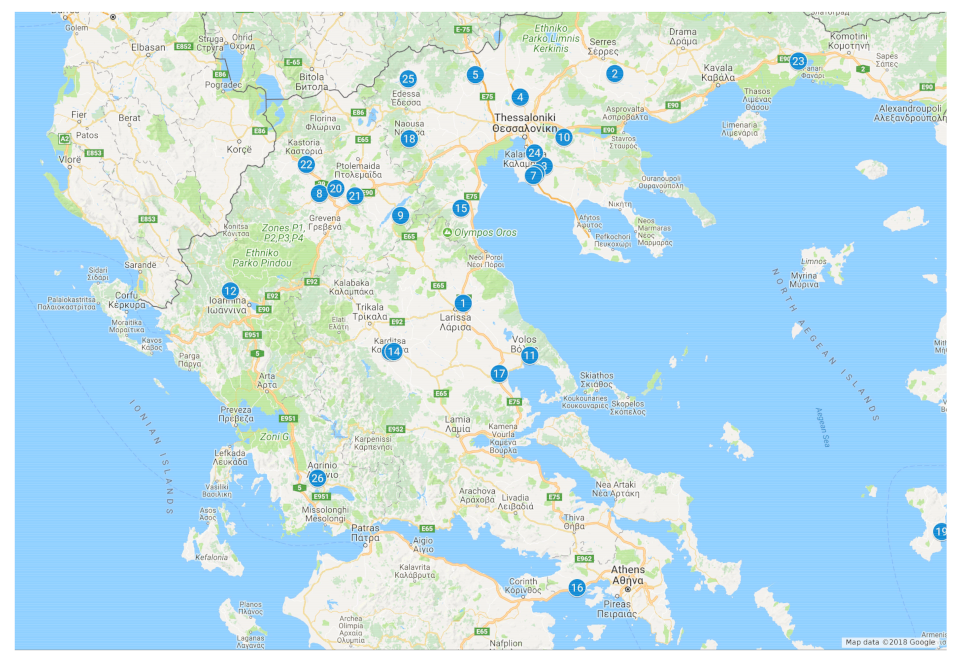
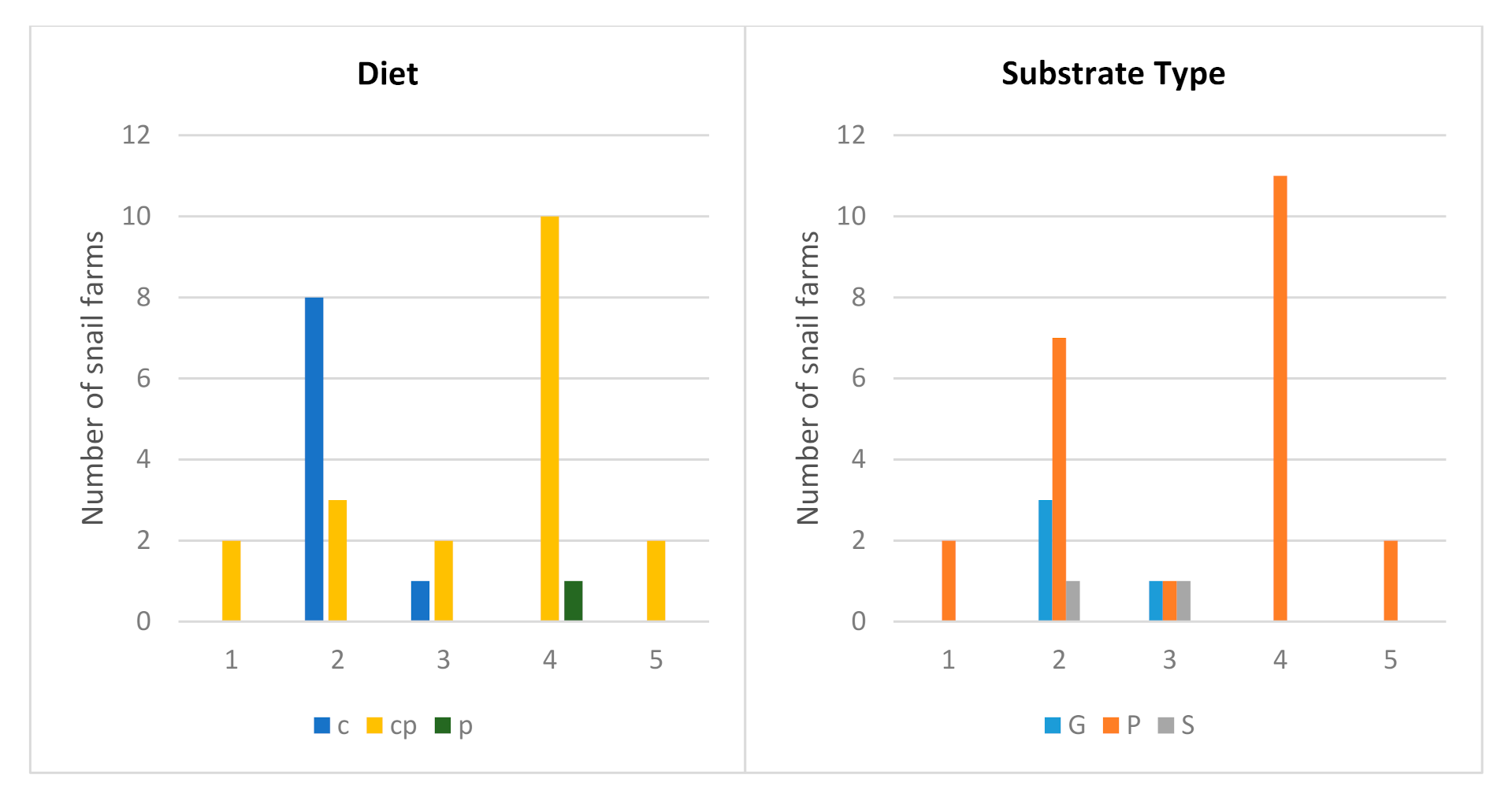
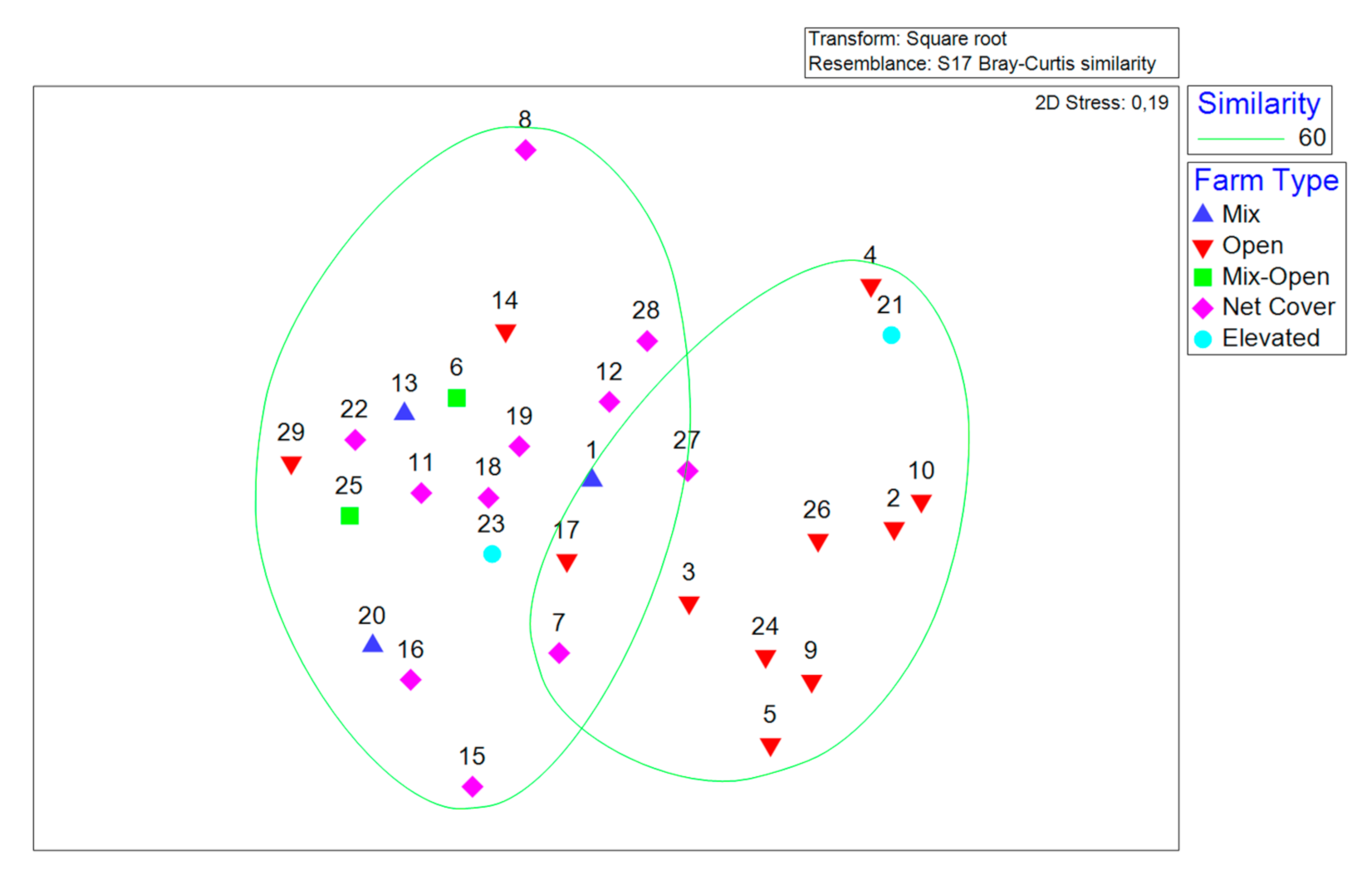
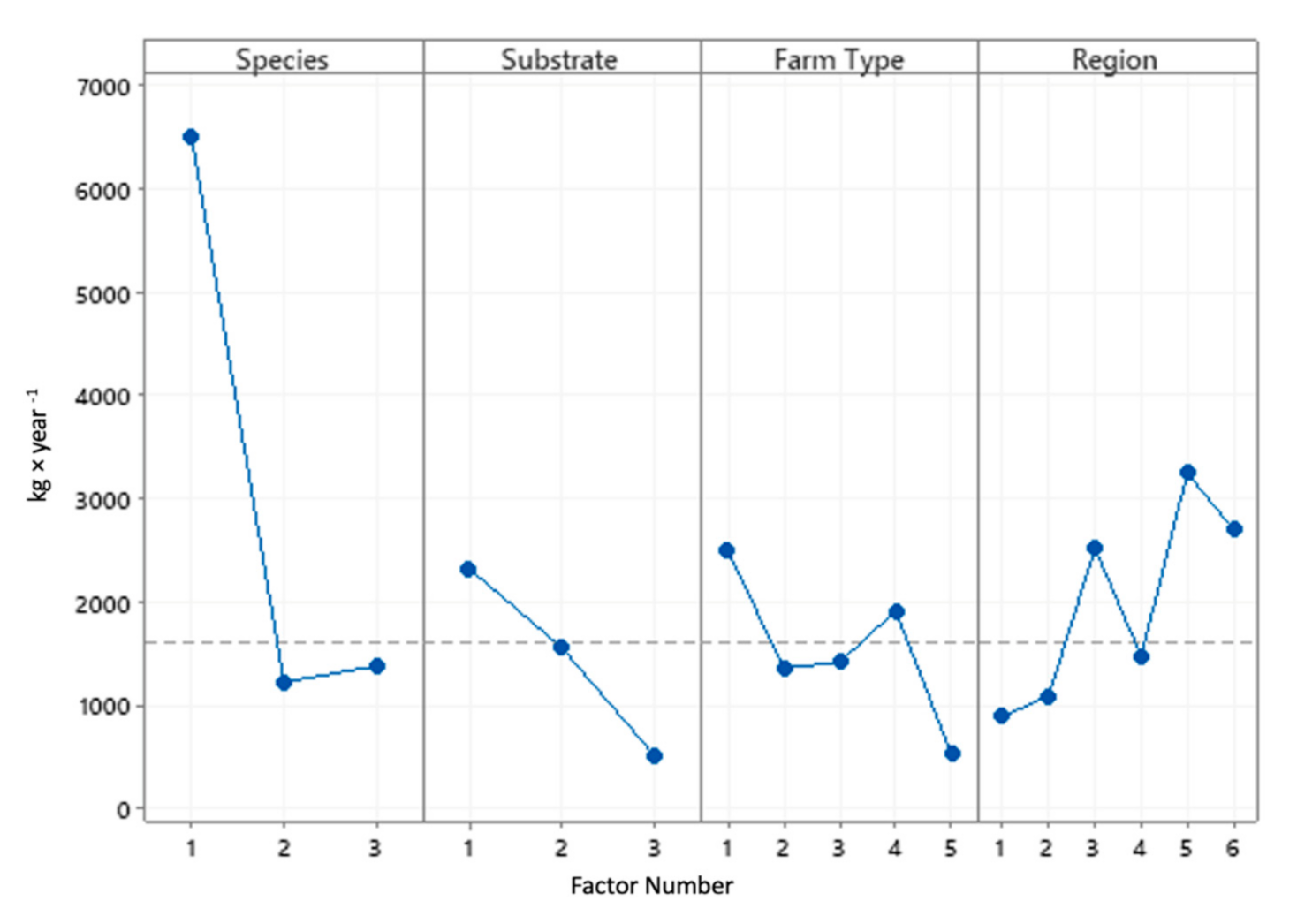
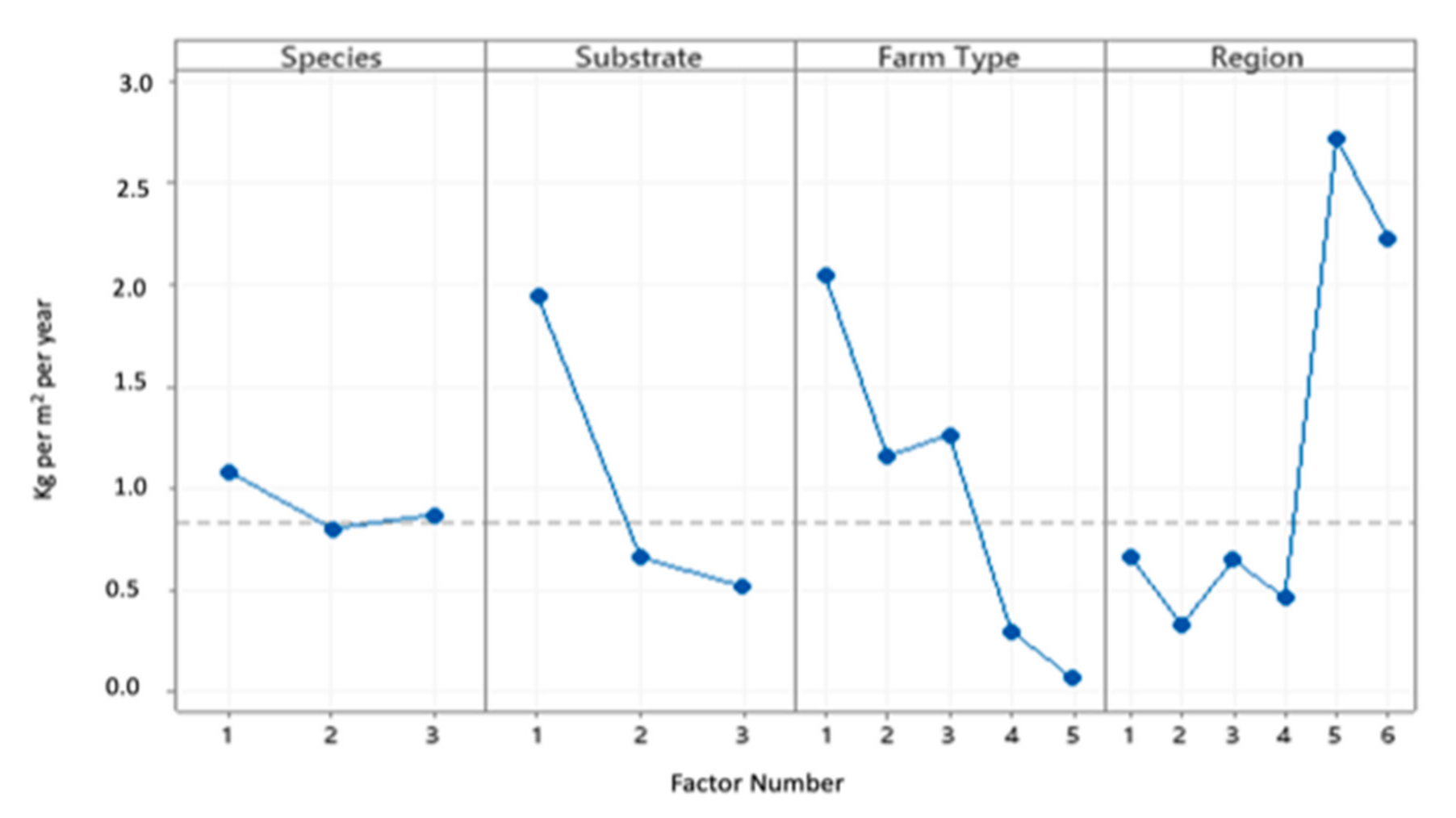
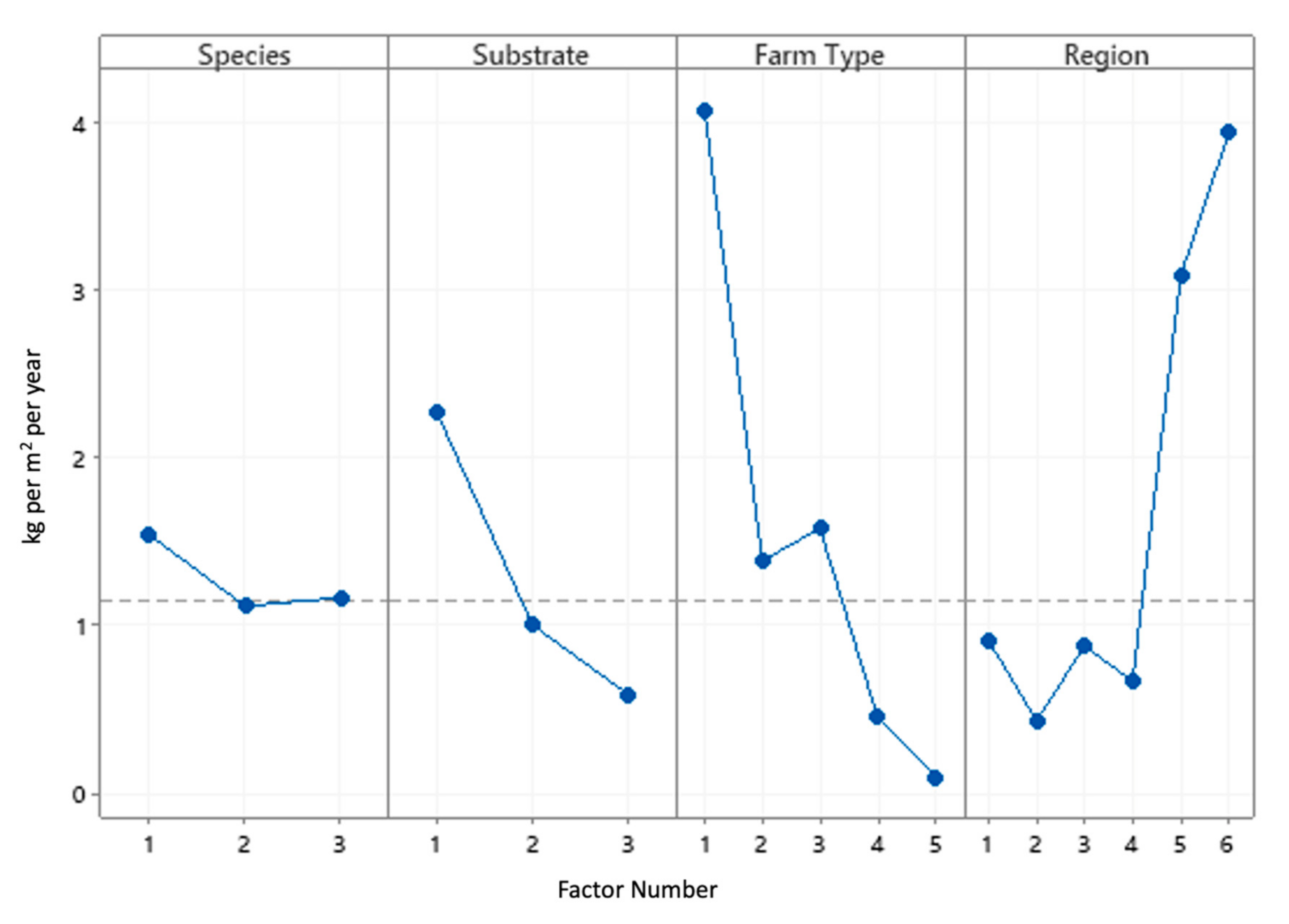
| Variable | Number | Mean | SE | St. Dev. | Min | Median | Max |
|---|---|---|---|---|---|---|---|
| Farmer’s Experience (years) | 29 | 4.83 | 0.43 | 2.32 | 1 | 5.00 | 13 |
| Farmer’s age (years) | 29 | 44.14 | 1.63 | 8.77 | 31 | 45 | 60 |
| Growth rate (gr × day−1 × snail−1) | 29 | 0.11 | 0.007 | 0.04 | 0.059 | 0.096 | 0.1930 |
| Number of Snails × kg−1 | 29 | 79.51 | 3.98 | 21.43 | 54.41 | 75.30 | 168.07 |
| Number of snails (year) | 29 | 138,043 | 40,046 | 215,654 | 8636 | 75,851 | 1,120,381 |
| Snail weight (gr) | 29 | 13.13 | 0.48 | 2.58 | 5.95 | 13.28 | 18.38 |
| Mortality (%) | 19 | 22.1 | 19.2 | 10.4 | 3 | 25 | 50 |
| Altitude (m) | 29 | 223.8 | 46.4 | 249.7 | 0 | 108 | 759 |
| Farming area (m2) | 29 | 3838 | 839 | 4518 | 500 | 1500 | 16,000 |
| Beneficial surface (m2) | 29 | 2593 | 530 | 2853 | 350 | 1200 | 10,500 |
| Duration of operation (months) | 29 | 8 | 0.291 | 1.566 | 4 | 8 | 10 |
| Duration of reproductive period (days) | 29 | 158.28 | 5.75 | 30.95 | 120 | 150 | 210 |
| Rearing Duration (days) | 29 | 241.52 | 8.69 | 46.78 | 120 | 240 | 270 |
| Dry Feed Quantity (kg × year−1) | 25 | 1628.86 | 404.15 | 2194.84 | 100 | 915 | 10,000 |
| Cooling system (min × day−1) | 29 | 22.07 | 1.7 | 9.15 | 6 | 20 | 45 |
| Shade rate of net (%) | 17 | 72.94 | 2.539 | 10.467 | 50 | 70 | 90 |
| Farm Production (kg × year−1) | 29 | 1597 | 375 | 2018 | 100 | 1000 | 10,005 |
| Productivity (kg × m2)−1 × year−1) | 29 | 0.829 | 0.185 | 0.996 | 0.035 | 0.400 | 4.435 |
| Prod. per Ben. Surf. (kg × (m2)−1 × year−1) | 29 | 1.148 | 0.264 | 1.420 | 0.058 | 0.583 | 6.154 |
| Estimated income (€ × year−1) | 29 | 7281 | 1839 | 9903 | 500 | 3750 | 50,000 |
| Farm System | Ν (%) | Main Facilities | Rearing Stages | Species |
|---|---|---|---|---|
| Elevated sections | 2 (7%) | Elongated raised panel boxes separated for reproduction and fattening | Reproduction, hatching and fattening of a brood, under semi—natural environment | Cornu aspersum maximum |
| Net—covered greenhouse | 11 (38%) | Net-covered greenhouse. Inside, divided sections separated by net | Reproduction and fattening under semi—natural environment | Cornu aspersum maximum (9 farms), Cornu aspersum aspersum (1 farm), Both (1 farm) |
| Mixed system with net-covered greenhouse | 3 (10%) | Hatchery Net-covered greenhouse | Reproduction and hatching under a controlled environment, fattening under a semi-natural environment | Cornu aspersum maximum |
| Open field | 11 (38%) | Open field. Divided sections separated by net | Outdoor reproduction and fattening | Cornu aspersum maximum (9 farms) Cornu aspersum aspersum (1 farm) Both (1 farm) |
| Mixed system with open field | 2 (7%) | Hatchery Open field | Reproduction and hatching under a controlled environment. Outdoor Fattening | Cornu aspersum maximum |
| 1 (n = 2) | 2 (n = 11) | 3 (n = 3) | 4 (n = 11) | 5 (n = 2) | ||
|---|---|---|---|---|---|---|
| Attributes | Mean | Mean ± SD | Mean ± SD | Mean ± SD | Mean | |
| Staff | Experience of farmer (years) | 4 | 5.45 ± 3.05 | 3.3 ± 2.1 | 4.8 ± 1.8 | 4.5 |
| Farmer’s age (years) | 43.5 | 40.1 ± 9.5 | 44.3 ± 1.15 | 46.3 ± 8.5 | 55 | |
| Livestock | Growth rate (gr × day−1 × snail−1) | 0.15 | 0.1 ± 0.03 | 0.14 ± 0.04 | 0.09 ± 0.04 | 0.14 |
| Number of snails/kg | 75.3 | 79.9 ± 30.4 | 68.1 ± 4.89 | 84.9 ± 13.9 | 68.8 | |
| Land | Altitude (m) | 554.5 | 305.36 ± 279 | 64 ± 54.4 | 138 ± 195.2 | 156 |
| Farming area (m2) | 3150 | 4200 ± 4526.6 | 1583.3 ± 1233.2 | 4414.5 ± 5682.4 | 5000 | |
| Beneficial surface (m2) | 2270 | 3074.5 ± 3262.3 | 1166.7 ± 814.5 | 2725.6 ± 3208.6 | 3250 | |
| Management | Duration of operation (months) | 9 | 8.36 ± 1.69 | 8 | 7.9 ± 1.81 | 7 |
| Duration of reproduction period (days) | 180 | 171.8 ± 27.1 | 160 ± 45.8 | 144.5 ± 29.4 | 135 | |
| Rearing duration (days) | 270 | 254.5 ± 48.8 | 240 | 240 ± 55.3 | 210 | |
| Dry feed quantity (kg × year−1) | 850 | 2080 ± 2879.9 | 609.3 ± 447.9 | 1607 ± 1997.7 | 760 | |
| Farm production (kg × year−1) | 2500 | 1358.7 ± 1611.3 | 1416.7 ± 520.4 | 1913.6 ± 2779.4 | 528.5 | |
| Estimated income (€ × year−1) | 3500 | 3849.5 ± 1857.9 | 6996.7 ± 9570 | 11,400 ± 14,397 | 5363.7 |
| 1 (n = 2) | 2 (n = 11) | 3 (n = 3) | 4 (n = 11) | 5 (n = 2) | |
|---|---|---|---|---|---|
| Facilities | |||||
| Harvest Warehouse | 2 | 10 | 3 | 10 | 2 |
| Hatchery | 0 | 0 | 2 | 0 | 1 |
| Packaging station | 1 | 2 | 1 | 2 | 0 |
| Cooling chamber | 1 | 3 | 1 | 2 | 2 |
| Equipment | |||||
| Fabric for low temperature | 2 | 6 | 1 | 9 | 0 |
| Shelters (wooden) | 1 | 10 | 3 | 6 | 2 |
| Cages | 0 | 3 | 1 | 2 | 1 |
| Tatters | 1 | 6 | 2 | 6 | 1 |
| Egg storage containers | 0 | 0 | 2 | 0 | 1 |
| Temperature and humidity sensors | 0 | 7 | 1 | 2 | 2 |
| Packaging materials | 1 | 7 | 2 | 6 | 2 |
| Agricultural tools | 1 | 9 | 3 | 10 | 2 |
| Factor | Number | Mean | SE | St. Dev. | Min | Median | Max |
|---|---|---|---|---|---|---|---|
| Species | (n) | ||||||
| 1 | 2 | 6503 | 3000 | 6503 | 10,005 | ||
| 2 | 25 | 1221 | 251 | 1254 | 100 | 735 | 5500 |
| 3 | 2 | 1382 | 1360 | 1382 | 1404 | ||
| Substrate | (n) | ||||||
| 1 | 4 | 2326 | 1108 | 2217 | 400 | 1702 | 5500 |
| 2 | 23 | 1563 | 432 | 2073 | 100 | 1000 | 10,005 |
| 3 | 2 | 521 | 170 | 521 | 872 | ||
| Farm type | (n) | ||||||
| 1 | 2 | 2500 | 1000 | 2500 | 4000 | ||
| 2 | 11 | 1359 | 486 | 1611 | 100 | 872 | 5500 |
| 3 | 3 | 1417 | 300 | 520 | 1000 | 1250 | 2000 |
| 4 | 11 | 1914 | 838 | 2779 | 400 | 735 | 10,005 |
| 5 | 2 | 528.5 | 500.0 | 528.5 | 557.0 | ||
| Region | (n) | ||||||
| 1 | 11 | 890 | 170 | 563 | 100 | 700 | 2000 |
| 2 | 6 | 1092 | 289 | 709 | 400 | 907 | 2000 |
| 3 | 6 | 2518 | 1556 | 3812 | 170 | 868 | 10,005 |
| 4 | 2 | 1475 | 450 | 1475 | 2500 | ||
| 5 | 2 | 3250 | 1000 | 3250 | 5500 | ||
| 6 | 2 | 2702 | 1404 | 2702 | 4000 |
| Factor | Number | Mean | SE | St. Dev. | Min | Median | Max |
|---|---|---|---|---|---|---|---|
| Species | (n) | ||||||
| 1 | 2 | 1.083 | 0.667 | 1.083 | 1.500 | ||
| 2 | 25 | 0.805 | 0.211 | 1.056 | 0.035 | 0.367 | 4.435 |
| 3 | 2 | 0.872 | 0.368 | 0.872 | 1.376 | ||
| Substrate | (n) | ||||||
| 1 | 4 | 1.938 | 0.870 | 1.740 | 0.400 | 1.457 | 4.435 |
| 2 | 23 | 0.663 | 0.158 | 0.759 | 0.035 | 0.367 | 3.077 |
| 3 | 2 | 0.521 | 0.170 | 0.521 | 0.872 | ||
| Farm type | (n) | ||||||
| 1 | 2 | 2.04 | 1.00 | 2.04 | 3.08 | ||
| 2 | 11 | 1.159 | 0.379 | 1.258 | 0.170 | 0.872 | 4.435 |
| 3 | 3 | 1.263 | 0.156 | 0.269 | 1.000 | 1.250 | 1.538 |
| 4 | 11 | 0.2981 | 0.0777 | 0.2576 | 0.0564 | 0.2333 | 0.8333 |
| 5 | 2 | 0.0674 | 0.0348 | 0.0674 | 0.1000 | ||
| Region | (n) | ||||||
| 1 | 11 | 0.668 | 0.200 | 0.663 | 0.035 | 0.400 | 2.133 |
| 2 | 6 | 0.328 | 0.190 | 0.466 | 0.056 | 0.108 | 1.250 |
| 3 | 6 | 0.651 | 0.213 | 0.521 | 0.170 | 0.517 | 1.500 |
| 4 | 2 | 0.462 | 0.090 | 0.462 | 0.833 | ||
| 5 | 2 | 2.72 | 1.00 | 2.72 | 4.44 | ||
| 6 | 2 | 2.227 | 1.376 | 2.227 | 3.077 |
| Factor | Number | Mean | SE | St. Dev. | Min | Median | Max |
|---|---|---|---|---|---|---|---|
| Species | (n) | ||||||
| 1 | 2 | 1.544 | 1.213 | 1.544 | 1.875 | ||
| 2 | 25 | 1.115 | 0.304 | 1.518 | 0.058 | 0.479 | 6.154 |
| 3 | 2 | 1.167 | 0.613 | 1.166 | 1.721 | ||
| Substrate | (n) | ||||||
| 1 | 4 | 2.268 | 0.941 | 1.881 | 0.5 | 3.402 | 4.928 |
| 2 | 23 | 1.002 | 0.279 | 1.338 | 0.058 | 0.525 | 6.154 |
| 3 | 2 | 0.591 | 0.213 | 0.146 | 0.969 | ||
| Farm type | (n) | ||||||
| 1 | 2 | 4.077 | 2 | 1.029 | 6.154 | ||
| 2 | 11 | 1.386 | 0.427 | 1.416 | 0.213 | 0.5 | 4.928 |
| 3 | 3 | 1.579 | 0.194 | 0.337 | 1.250 | 1.25 | 1.923 |
| 4 | 11 | 0.452 | 0.124 | 0.411 | 0.071 | 1.212 | 1.213 |
| 5 | 2 | 0.101 | 0.058 | 0.142 | 0.143 | ||
| Region | (n) | ||||||
| 1 | 11 | 0.914 | 0.265 | 0.879 | 0.058 | 0.525 | 2.667 |
| 2 | 6 | 0.434 | 0.235 | 0.577 | 0.071 | 0.521 | 1.563 |
| 3 | 6 | 0.877 | 0.274 | 0.672 | 0.213 | 0.251 | 1.875 |
| 4 | 2 | 0.67 | 0.150 | 1.642 | 1.190 | ||
| 5 | 2 | 3.089 | 1.250 | 2.949 | 4.928 | ||
| 6 | 2 | 3.938 | 1.721 | 3.106 | 6.154 |
Publisher’s Note: MDPI stays neutral with regard to jurisdictional claims in published maps and institutional affiliations. |
© 2021 by the authors. Licensee MDPI, Basel, Switzerland. This article is an open access article distributed under the terms and conditions of the Creative Commons Attribution (CC BY) license (http://creativecommons.org/licenses/by/4.0/).
Share and Cite
Apostolou, K.; Staikou, A.; Sotiraki, S.; Hatziioannou, M. An Assessment of Snail-Farm Systems Based on Land Use and Farm Components. Animals 2021, 11, 272. https://doi.org/10.3390/ani11020272
Apostolou K, Staikou A, Sotiraki S, Hatziioannou M. An Assessment of Snail-Farm Systems Based on Land Use and Farm Components. Animals. 2021; 11(2):272. https://doi.org/10.3390/ani11020272
Chicago/Turabian StyleApostolou, Konstantinos, Alexandra Staikou, Smaragda Sotiraki, and Marianthi Hatziioannou. 2021. "An Assessment of Snail-Farm Systems Based on Land Use and Farm Components" Animals 11, no. 2: 272. https://doi.org/10.3390/ani11020272
APA StyleApostolou, K., Staikou, A., Sotiraki, S., & Hatziioannou, M. (2021). An Assessment of Snail-Farm Systems Based on Land Use and Farm Components. Animals, 11(2), 272. https://doi.org/10.3390/ani11020272






